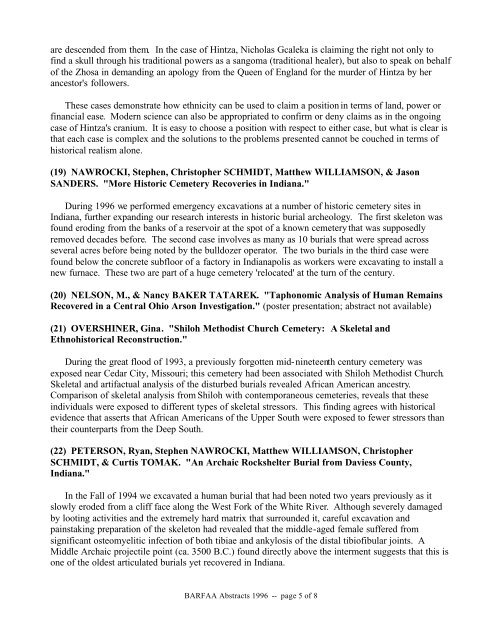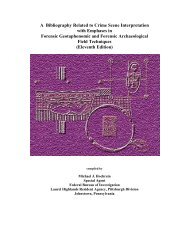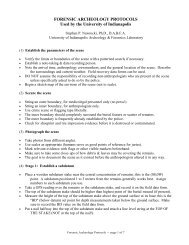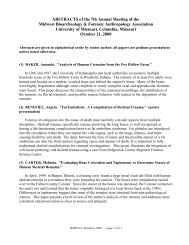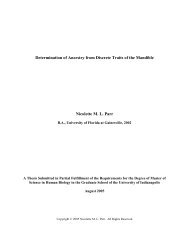Abstracts - University of Indianapolis Archeology & Forensics ...
Abstracts - University of Indianapolis Archeology & Forensics ...
Abstracts - University of Indianapolis Archeology & Forensics ...
Create successful ePaper yourself
Turn your PDF publications into a flip-book with our unique Google optimized e-Paper software.
are descended from them. In the case <strong>of</strong> Hintza, Nicholas Gcaleka is claiming the right not only to<br />
find a skull through his traditional powers as a sangoma (traditional healer), but also to speak on behalf<br />
<strong>of</strong> the Zhosa in demanding an apology from the Queen <strong>of</strong> England for the murder <strong>of</strong> Hintza by her<br />
ancestor's followers.<br />
These cases demonstrate how ethnicity can be used to claim a position in terms <strong>of</strong> land, power or<br />
financial ease. Modern science can also be appropriated to confirm or deny claims as in the ongoing<br />
case <strong>of</strong> Hintza's cranium. It is easy to choose a position with respect to either case, but what is clear is<br />
that each case is complex and the solutions to the problems presented cannot be couched in terms <strong>of</strong><br />
historical realism alone.<br />
(19) NAWROCKI, Stephen, Christopher SCHMIDT, Matthew WILLIAMSON, & Jason<br />
SANDERS. "More Historic Cemetery Recoveries in Indiana."<br />
During 1996 we performed emergency excavations at a number <strong>of</strong> historic cemetery sites in<br />
Indiana, further expanding our research interests in historic burial archeology. The first skeleton was<br />
found eroding from the banks <strong>of</strong> a reservoir at the spot <strong>of</strong> a known cemetery that was supposedly<br />
removed decades before. The second case involves as many as 10 burials that were spread across<br />
several acres before being noted by the bulldozer operator. The two burials in the third case were<br />
found below the concrete subfloor <strong>of</strong> a factory in <strong>Indianapolis</strong> as workers were excavating to install a<br />
new furnace. These two are part <strong>of</strong> a huge cemetery 'relocated' at the turn <strong>of</strong> the century.<br />
(20) NELSON, M., & Nancy BAKER TATAREK. "Taphonomic Analysis <strong>of</strong> Human Remains<br />
Recovered in a Central Ohio Arson Investigation." (poster presentation; abstract not available)<br />
(21) OVERSHINER, Gina. "Shiloh Methodist Church Cemetery: A Skeletal and<br />
Ethnohistorical Reconstruction."<br />
During the great flood <strong>of</strong> 1993, a previously forgotten mid-nineteenth century cemetery was<br />
exposed near Cedar City, Missouri; this cemetery had been associated with Shiloh Methodist Church.<br />
Skeletal and artifactual analysis <strong>of</strong> the disturbed burials revealed African American ancestry.<br />
Comparison <strong>of</strong> skeletal analysis from Shiloh with contemporaneous cemeteries, reveals that these<br />
individuals were exposed to different types <strong>of</strong> skeletal stressors. This finding agrees with historical<br />
evidence that asserts that African Americans <strong>of</strong> the Upper South were exposed to fewer stressors than<br />
their counterparts from the Deep South.<br />
(22) PETERSON, Ryan, Stephen NAWROCKI, Matthew WILLIAMSON, Christopher<br />
SCHMIDT, & Curtis TOMAK. "An Archaic Rockshelter Burial from Daviess County,<br />
Indiana."<br />
In the Fall <strong>of</strong> 1994 we excavated a human burial that had been noted two years previously as it<br />
slowly eroded from a cliff face along the West Fork <strong>of</strong> the White River. Although severely damaged<br />
by looting activities and the extremely hard matrix that surrounded it, careful excavation and<br />
painstaking preparation <strong>of</strong> the skeleton had revealed that the middle-aged female suffered from<br />
significant osteomyelitic infection <strong>of</strong> both tibiae and ankylosis <strong>of</strong> the distal tibi<strong>of</strong>ibular joints. A<br />
Middle Archaic projectile point (ca. 3500 B.C.) found directly above the interment suggests that this is<br />
one <strong>of</strong> the oldest articulated burials yet recovered in Indiana.<br />
BARFAA <strong>Abstracts</strong> 1996 -- page 5 <strong>of</strong> 8


